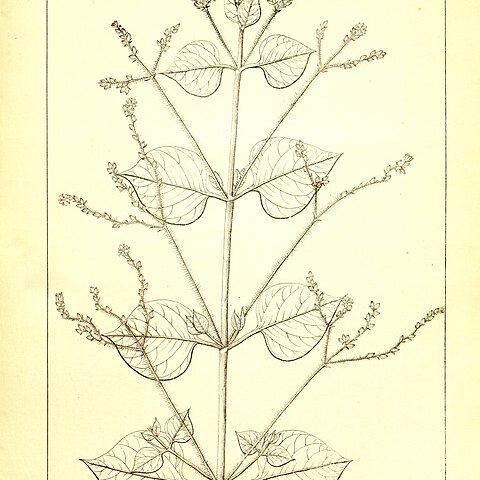Tepals, green, acute, prominently 3-nerved with the nerves confluent at the apex and excurrent in a minute mucro, glabrous or usually more or less furnished with spreading, white, multicellular, minutely denticulate hairs; outer 2 tepals 2–2.5 mm. long, narrowly hyaline-margined with all 3 nerves equally strong, if hairs present then all nerves white-pilose, hairs sometimes also present on the surfaces between; inner 2 widely hyaline-margined (the margin wider than the nerved central portion at halfway up the tepal), pilose only along the midrib, which is much stronger than the lateral nerves; middle tepal with one side as in the outer 2 and one as in the inner 2.
Main stem and branch leaves cordate-ovate to broadly ovate or rarely cordate-lanceolate,obtuse to acuminate at the apex, 1.3–7 × 0.7–5.2 cm., the lowest on petioles up to c. 1 (1.8) cm. long, leaves towards the ends of the stem and branches reducing in size and almost sessile; indumentum of mature leaves very variable, from green on both surfaces and moderately softly appressed-pilose below and thinly so with long and shorter multicellular, strigose hairs above to moderately appressed-pilose above and densely silvery-sericeous on the lower surface (always so in young leaves).
Stem and branches striate, the lower internodes terete, the upper subquadrate and more or less sulcate, nodes somewhat swollen; indumentum very variable, from subglabrous or with sparse soft pubescence to densely pilose with a double indumentum of shorter soft hairs and long, fine, multicellular, spreading bristly hairs (even when absent elsewhere tufts of bristly hairs occur between the branches and leaves at least of the upper nodes, frequently forming an annulus there).
Inflorescence a large, open compound panicle, of axillary opposite panicles formed of simple or branched spikes, each with a flexuose, glabrous rhachis; peduncle and branches of the partial inflorescences capillary, glabrous or with long, strigose, multicellular hairs, the axes zigzag; bracts lanceolate, 0.75–1 mm. long, sparingly pilose, mucronate with the excurrent midrib; bracteoles similar but slightly shorter.
Erect or occasionally prostrate or ascending annual herb, with numerous stems c. 0.3–1 m. tall, much-branched in the lower half and frequently also above, the lowest internodes of particularly the lower branches very divergent.
Seed subglobose, black, shining, feebly reticulate, c. 1.5 mm. in diam.
Stamens delicate, c. 1.5–1.75 mm. long; pseudostaminodes none.
Capsule ovoid, c. 1.75–2 mm. long.
Style short, c. 0.5 mm. long.
Flowers sessile.
A herb.

